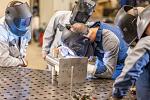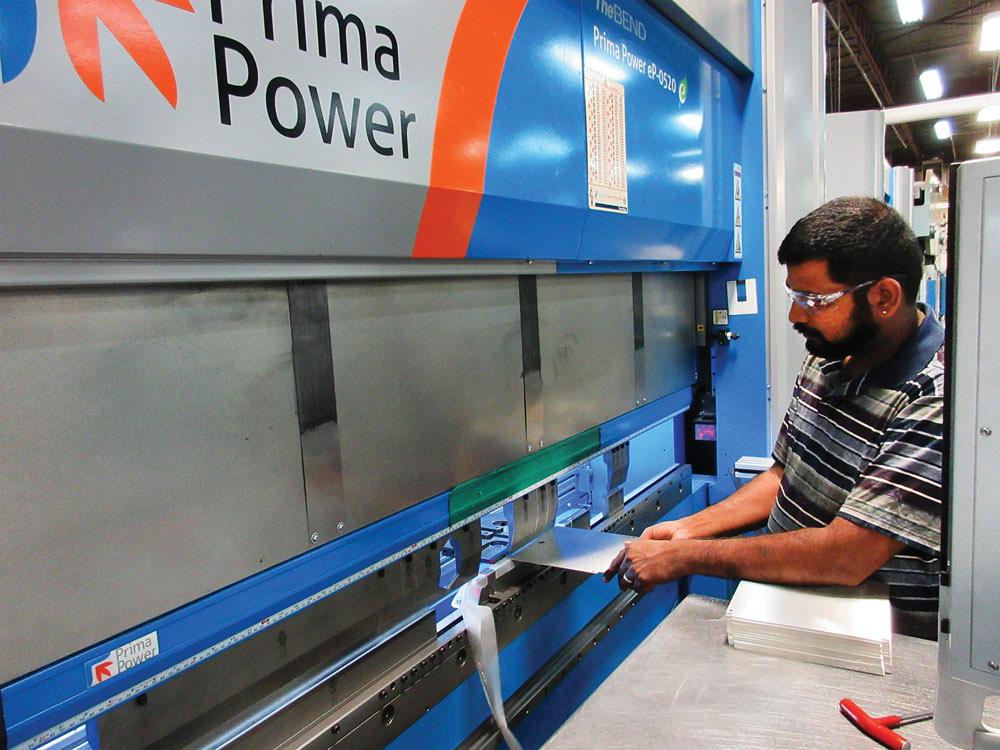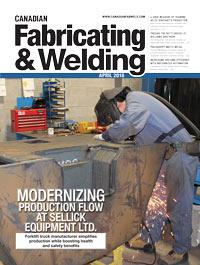- FMA
- The Fabricator
- FABTECH
- Canadian Metalworking
Freeing the bottlenecks at Williams Brothers
Fire extinguisher manufacturer smokes out waste with punch/shear combo machine
- April 17, 2018
- Article
- Fabricating

Williams Brothers’ General Manager Shaun Dooner stands on the shop floor in front of the company’s Prima Power Shear Genius® (SGe) punch/shear combination machine.
The Williams Brothers Corp., Scarborough, Ont., is a manufacturer of fire extinguishers and fire equipment cabinetry. Tracing its roots to 1908, the company is now in its third generation with Bill Williams as owner/president.
Originally founded as a fire extinguisher service company, the firm has evolved into two corporations over the past century: The Williams Brothers Corp., which fabricates all the sheet metal products such as fire extinguisher cabinets, safety storage cabinets, propane and welding cages, access doors, racks, trays, and boxes; and the Strike First Corp., which is a distributor of portable fire extinguishers.
According to Shaun Dooner, general manager, the company began fabricating sheet metal products in the mid-1960s. “It all began with just a shear and a piercing machine,” said Dooner. “And here we are today with a full range of fire equipment and access panel product lines manufactured with technologically advanced fabricating equipment.”
Williams Brothers added fabrication equipment through the years to fill growing production demands. Eventually the company began searching for increased production and faster throughput.
“As the order book got increasingly full, we experienced more bottlenecks in the manufacturing process,” explained Dooner. “There is only so much you can do to counteract the bottlenecks before you have to look at automation. At one point a laser we had purchased went down for several weeks. That prompted our search for equipment that would allow us to increase our throughput, reduce our error rate, increase our accuracy, and allow for better control on process flow.”
To expedite this process, Williams Brothers managers attended the 2014 FABTECH® Canada show in Toronto and purchased a Prima Power Shear Genius® (SGe) punch/shear combination and a SYNCRONO® fibre laser.
Lights-out Production Opportunities
The punch/shear combination machine is designed to load, punch, form, upform, unload, sort, and stack parts so they can be sent immediately to final assembly. The heart of the machine is a servo-electric, 30-metric-ton punching system with 1,000 hits per minute stroke speed, 250-RPM index speed, and 150-m/min. sheet positioning speed. The right-angle shear has a servo-electric actuation system, which makes shear movement both fast and fully CNC. Material thickness in shearing can be up to 5 mm for aluminum, 4 mm for mild steel, and 3 mm for stainless steel. Automatic loading has been integrated, and both part removal and part sorting are programmable and automatic, meaning that the machine can easily be set to run lights-out with minimal setup times.
The machine eliminates skeletons and secondary operations such as deburring. Nibbled edges on the part exteriors are eliminated using the integrated right-angle shear. The sheet is loaded and squared automatically, without human interference. The same clamps that hold the sheet for punching also hold it for shearing.
“When I look at the SGe, I see an endless amount of possibilities,” said Dooner. “With its ability to create louvres and perforated standoffs, it becomes a 3-D machine. We load sheets on one side of the machine and unload finished parts on the other side ... it doesn’t get much easier than that.”
New Applications
The punch/shear machine’s flexibility has allowed the management team to streamline manufacturing on some product lines.
“At one time we were building some of our boxes out of three pieces, two of them stamped on a 350-ton press,” said Dooner. “We partnered with Mate Precision Tooling to develop a snap-lock tool for the SGe that allowed us to make the three-piece block out of one sheet. The part is punched, sheared, formed, and locked on the press brake and then sent directly to the paint line. This has eliminated the hard tooling, the foot coils, the need for the 350-ton stamping press, and the spot welding to assemble all three pieces together.
“This has been a game-changer for us, and when you are tracking delivery compliance percentages as a measure of success in your manufacturing environment, this has really increased throughput for those product lines. Because we have been able to eliminate spot welding and heavy stamping from the equation, I have freed up capacity hours in those two departments. That has allowed me to increase throughput for spot welding parts and stamped parts. It has been a win/win throughout our manufacturing process. I couldn’t have done this without the SGe and our tooling supplier.”
Laser Flexibility
The SYNCRONO fibre laser has 6-G acceleration for processing thin sheets. The machine is two synchronized mechanisms in one: one small, light head with high dynamics and one larger machine with a wide working area. The two are coordinated by patented algorithms for optimum distribution of movements throughout the axes. An active compensation cancels the vibrations deriving from the high dynamics.
The machine can process materials such as high-reflecting brass and copper. Electricity consumption is reduced through the user of lower power and high source efficiency, without a turbine, optical chain, or filters.
Servo-electric Press Brakes
In August 2017 the company acquired two Prima Power servo-electric eP-0520 press brakes.
Prima Power has applied a servo-electric drive system on this new press brake series. With no hydraulics, it uses less power, requires less maintenance, and requires no oil, according to the company.
The brake is built on a rigid O-frame, which helps to ensure tool alignment even under stress deformation since there is no horizontal displacement. The position of the upper beam in relation to the lower beam is measured by dual Y1 and Y2 linear encoders that are attached independent of the machine frame and are bed-referenced; this function maintains accurate positioning even during off-centre bending operations. Ram repeatability on the brake is ± 0.005 mm.
“We replaced two older 2-axis machines with 5-axis servo-electric press brakes,” said Dooner. “We’ve never worked with this level of accuracy. I also really like the safety features of that machine. The press brakes are almost maintenance-free. Their repeatability and accuracy of 0.005 is impressive. We had accuracy problems with the older press brakes, so all new programs developed through R&D are scheduled on the new Prima Power press brakes.”
Williams Brothers Corp., www.williams-brothers.com/index.html
Prima Power, www.primapower.com
subscribe now


Keep up to date with the latest news, events, and technology for all things metal from our pair of monthly magazines written specifically for Canadian manufacturers!
Start Your Free Subscription- Trending Articles
Class is in session for college connections

BlueForge Alliance partners with Nuts, Bolts & Thingamajigs to develop Submarine Manufacturing Camps

Engine-driven welding machines include integrated air compressors

Orbital tube welding webinar to be held April 23

Portable system becomes hot tech in heat treatment

- Industry Events
ZEISS Quality Innovation Days 2024
- April 15 - 19, 2024
Tube 2024
- April 15 - 19, 2024
- Düsseldorf, Germany
CTMA Economic Uncertainty: Helping You Navigate Windsor Seminar
- April 30, 2024
- Windsor, ON Canada
MME Winnipeg
- April 30, 2024
- Winnipeg, ON Canada
CTMA Economic Uncertainty: Helping You Navigate Kitchener Seminar
- May 2, 2024
- Kitchener, ON Canada


















